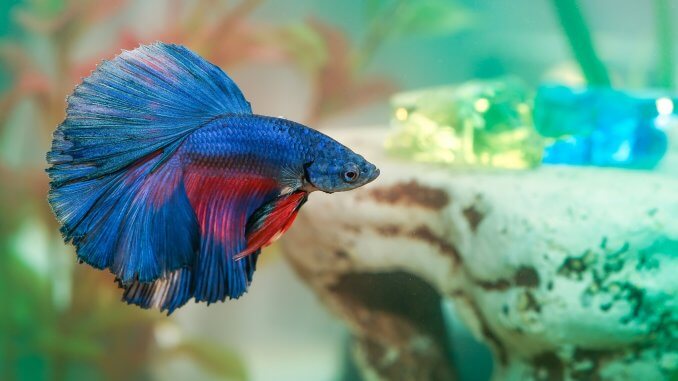
First-time fish-keepers often underestimate how much care their new pets will need. Betta fish (also known as Siamese fighting fish) are beautiful and popular pets that need plenty of care to flourish.
This article discusses how fish keepers can keep their bettas happy and healthy, and how to recognize signs of illness in your pet, and whether or not caring for a betta fish is suitable for beginners.
TABLE OF CONTENTS
Quick Betta Fish Care Guide
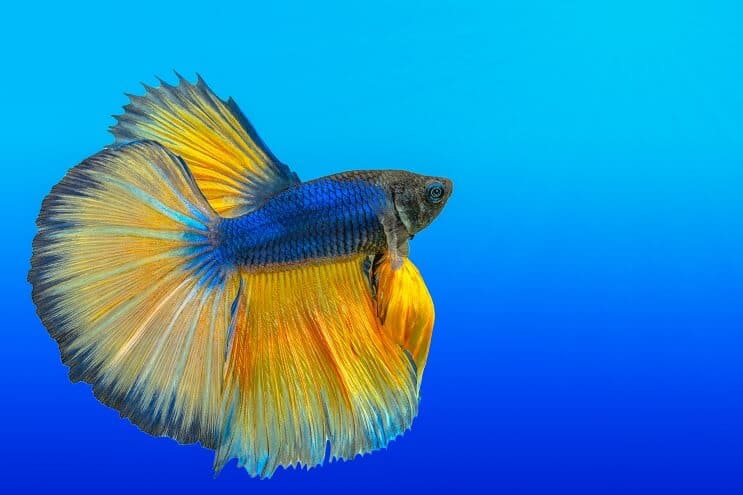
With a little preparation and care, first-time fish owners can raise healthy, happy bettas.
Here’s a quick list of everything you should consider before you buy a new betta fish:
- Diet and feeding: Betta fish need a combination of flakes, pellets, and freeze-dried or live food
- Tank setup: Betta fish need a five-gallon tank, or larger, along with a good water filter and heater. A low-level air pump can help to oxygenate the water, but remember that bettas prefer still water
- Habitat and maintenance: Bettas like having places to hide. Put decorations, including live plants, in the tank. Maintain water temperature between 76 and 85°F. Change 15% to 40% of the water weekly
- Characteristics and compatibility: Bettas — especially males — can be aggressive. Keep female bettas together, and don’t combine males with females or with other males. Some bettas are more territorial than others. Bettas are compatible with placid, bottom-feeding, dull-colored fish
- Betta fish health: A healthy betta is active, alert, and eats regularly. The males should have vibrant colors and show an active interest in their surroundings. Bettas that don’t eat, have dull colors, and act lethargic could be sick
Betta Fish Care Tips
Any good pet owner wants their pet to thrive. Keep betta fish healthy with the proper tank set-up. Here are a few tips that can help you make sure your betta is thriving in its environment:
- Buy a bigger tank than you need: Bettas aren’t very active fish, but maintaining a larger tank is easier than maintaining a smaller one. If you intend to add more fish to your tank besides your betta, you’ll need plenty of extra space
- Check your fish every day: Betta fish have recognizable signs of illness and stress. Inspect your betta fish daily for signs of poor health
- Feed your betta a varied diet: A healthy betta has a good appetite and thrives on a varied diet
- Wait at least two to four weeks before adding new fish: Betta fish need at least two to four weeks to settle into their new home before adding new fish
Diet and Feeding
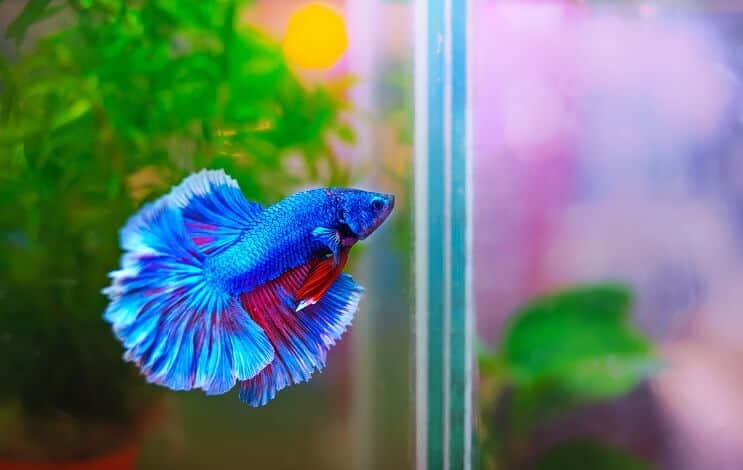
In the wild, bettas eat small insects and other small invertebrates. You may struggle to feed your bettas live insects, but you can get frozen foods that are suitable for these fish.
Here are a few things to consider when feeding your bettas:
- Feed bettas a varied diet of pellets, flakes, and frozen or live foods
- Feed sparingly, once a day. If given the chance, betta fish will eat more than they need. Uneaten food will dissolve and pollute the tank. Feed bettas an amount they can eat within two minutes, and scoop out any uneaten food
- Feed baby bettas a diet of finer flakes and crushed pellets
- Give bettas occasional treats. Bloodworms, live food, and finely chopped meat are suitable for bettas. Scoop out any uneaten food
Tank Setup
Prized for their beauty, bettas are very popular fish. Unfortunately, this has led to some pet owners keeping betta fish for their looks and not bothering to take care of them. A common myth is that bettas do just fine in tiny, undecorated glass vases.
Keeping any fish in a tiny living space is cruel, and bettas are no exception. Bettas need clean water and a sizable, decorated tank to thrive.
Before you bring home your new betta fish, set up and cycle the tank.
Here’s what your betta tank setup will need:
- Tank size: At least 5 gallons in size. If you plan to add more fish to your aquarium, start with a minimum of 10 gallons
- Water temperature: Between 76 and 85°F.
- Water quality: Calm water, without strong currents, and with a pH of between 6.8 and 7.5. Use a pH testing kit to regularly check whether or not the tank water is suitable
- Decorations: Provide plenty of hiding places and decorations for your fish to explore. Live plants can be a good way of introducing oxygen into the water, and can also provide hiding places for your betta
Large fish bowls with the proper equipment are suitable for bettas, but never put any fish into a bare, empty, small bowl.
Habitat Maintenance
Keep the betta fish’s tank clean and mimic the fish’s habitat to keep the fish healthy.
Water Changes
How often you change the tank water will depend on the size of your tank and how many fish you’re keeping in it. For example, smaller tanks need more maintenance and more frequent water changes than larger tanks. The more fish you have, the more frequently the water will need to be changed.
Replace 15% to 40% of the tank’s water with fresh water every week.
Never change all of the water in the tank at once, even with your fish stored safely somewhere else. Tanks build up their own delicately balanced ecosystem of bacteria, and changing all of the water resets this ecosystem.
Putting your fish back into what is essentially a brand new tank could seriously damage the fish’s health, or even kill the fish.
Check Temperature
Bettas are tropical fish and need a water temperature of 76 to 85°F. The fish can tolerate slightly warmer or colder temperatures, but too hot or cold can lower your betta’s immunity and leave it weak and lethargic.
During hot or cold weather, weekly temperature checks can help you make sure the tank water is at optimal temperature.
Check Water Acidity
Bettas thrive in water with a pH of 6.8 to 7.5. If pH levels are out of balance, the tank water could contain high levels of ammonia or another substance that may hurt your betta. Too much ammonia will lead to gill burn, lethargy, and eventually death.
You can buy pH kits that allow you to quickly and easily check the water quality every week.
Inspect Decorations and Substrate
Unless there is an illness or algae problem in the tank the decorations in the tank don’t need to be cleaned often. However, it’s wise to inspect the decorations regularly, looking for wear, tear, or anything that might injure your fish.
It’s a good idea to use a gravel vacuum to clean the substrate when you’re doing a water change. Debris and algae can build up in the gravel.
Observe Your Betta Fish
While you’re conducting tank checks, you should have plenty of time to observe your beautiful betta. Look to see if the betta colors look vibrant and if the fins look healthy. If not, check the pH, temperature, and cleanliness of the tank and adjust as needed.
Characteristics and Compatibility
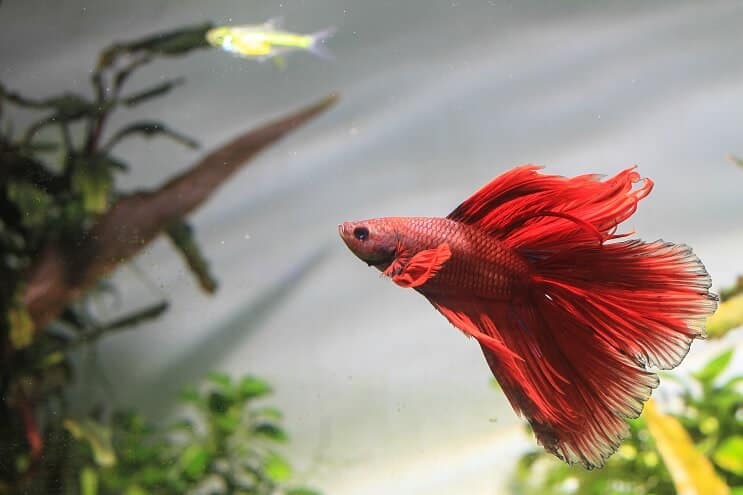
Betta fish tend to be aggressive towards some fish. Male bettas are territorial and mustn’t be kept with other males.
Male and female bettas have feisty, vibrant personalities. These fish are fun-loving, intelligent, and quickly learn to recognize their owners.
When choosing tank mates for your bettas, keep in mind that not every fish is compatible. Colorful fish with long fins or aggressive fish aren’t suitable for male bettas. Female bettas can also be territorial in some cases, although they’re generally less aggressive than males.
Here are a few fish that make good tankmates for bettas:
- Tetras (neon, amber)
- Corydoras (albino, bronze, and panda)
- Cherry barbs
- Mystery snails
- Ghost shrimp
- Feeder guppies (not fancy guppies — male bettas may mistake them for other males and attack)
- Harlequin rasboras
Make sure you have a big enough tank for all of your fish. For every inch of fish that is added, the tank will need another gallon of water. For example, a fish that measures two inches, plus a betta fish, require a minimum of 7 gallons of water, preferably more.
Ideally, for a community tank, plus a betta fish, you should start with a 10-gallon tank.
How to Take Care of a Betta Fish’s Health
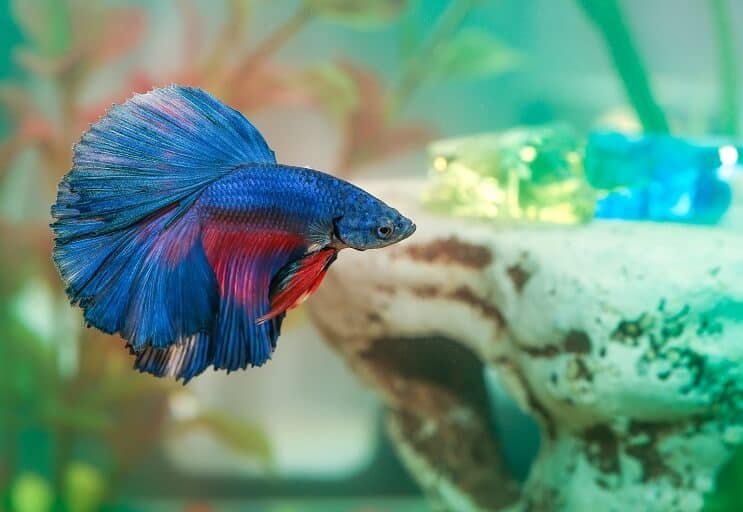
Sometimes your fish may get sick. It’s your responsibility to keep an eye on how your fish are doing and take steps to help them.
These are signs of a healthy fish:
- Vibrant colors: Bettas are renowned for their bright colors. Strong colors indicate that your fish is in good health
- Energetic swimming and a good appetite: Some bettas are lazier than others, but you should still see energy in your fish
- Alert: A healthy betta responds to outside stimuli by turning to or away from the stimuli
Here are a few signs that a fish is sick:
- Loss of color
- Loss of appetite
- Unnaturally colored spots on the fins or body (white and red are very common)
- Unnaturally frayed fins (crowntail bettas already have naturally frayed fins)
- Lethargy and listlessness
- Erratic swimming
- Bloating
- Labored breathing
Solving Common Betta Fish Issues
There are a few common health issues that plague betta fish. Some can be resolved by a water change, but others may need medication and veterinary attention.
Here are a few issues to watch out for:
- Fin rot: The fins look ragged or damaged. This can also be caused by keeping your betta with “fin nippers” — smaller fish that tend to bite. Improve the water quality of the tank, and do regular water tests. Consult a veterinarian for more advice
- Ich: White spots on the fins and body. The fish breathes rapidly and rubs itself against the substrate and tank decorations. Ich is highly contagious. Remove the infected fish to a quarantine tank immediately. There are commercial antifungal treatments for ich. Add the medication to the tank water as directed
- Ammonia poisoning: Lethargy, gulping for air, red, burned-looking gills, possibly aggression towards other fish. Conduct water changes immediately, or move the fish to a safe tank. Use pH testing kits to check the water
- Fungus: White cottony growth on the fins or body, and maybe eye discoloration. Quarantine the fish immediately, and use a commercial antifungal treatment as directed
Should You Get a Betta Fish?
Bettas are beautiful, unique, and highly rewarding fish to keep. With a little care and attention, even new fish-keepers can keep their bettas healthy, happy, and flourishing.

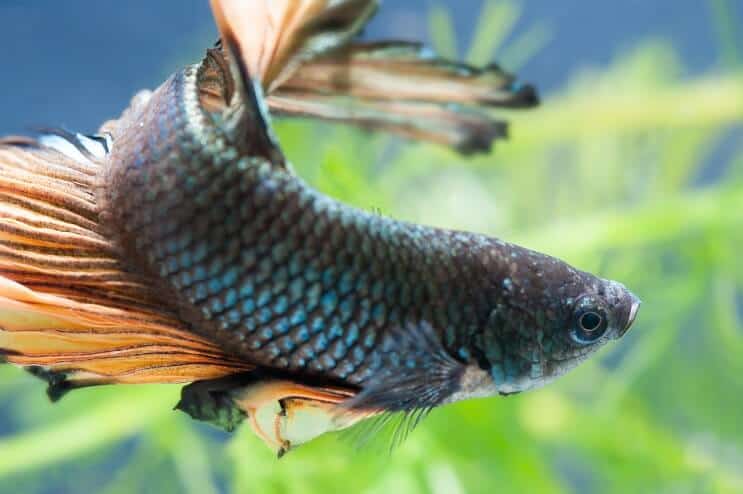

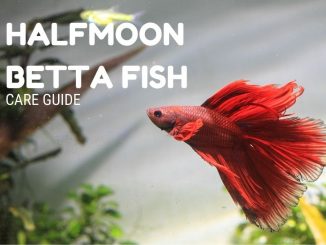
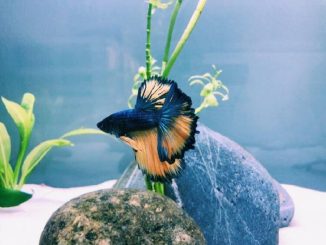
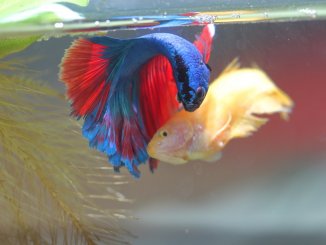
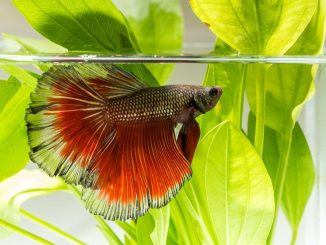
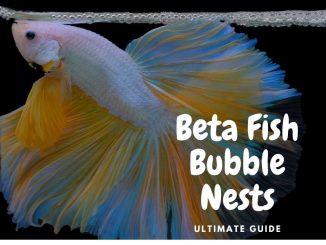
You wrote that you can alternatively keep two females and a male. Did you mean in place of a single male or in addition to? I’m fairly certain you meant in place of but if I’m wrong let me know!
Hi Brandon, yes you’re correct, this is in place of keeping a single male. Thanks, Robert
I have a black orchid male named eggplant. I have him in a one gallon tank with heater and filter. I change the water once a week. Sometimes twice a week. He gets sluggish before a water change. When I do the water change he gets excited. Starts making bubbles. Is it OK to do a water change twice a week?
Hi Linda, Let me advice you to move him to a 5 gallon tank. A one gallon tank really isn’t big enough for any fish. You’ll then also only need to do one water change a week too. He probably becomes sluggish because the nitrates build up in the water because it is such as small space. Thanks, Robert
My juvenile male half-moon betta peacefully co-exists with my fancy guppies. I was only going to have guppies in this particular tank (29 gallon) but when I saw “Moonshine” (he’s platinum) trying to jump out of the sad little cup he was it, I was smitten. I had done some research, and half-moon bettas are less aggressive and can be in a tank with guppies. He and his tank mates are fine; maybe because it’s a big planted tank, but Moonshine is young, (the same size as the guppies) and just flares at his own reflection, and doesn’t bother the guppies at all!
Hi, Robert! I have a male betta fish for a week now, my friend gave it to me as a present for my birthday. Both she and I never had fish, so she didn’t know that his pale colour, destroyed fins and bloated eyes were indications of sickness, fin rot. He was kept in a little cup with very poor conditions. I got worried and bought today a 14 gallon tank with two live plants, but I know very little about tank maintenance. Your article was very helpful though. I also bought medicine for his treatment, which seems serious. The filter is too strong for him and he can’t swim with his rotten fins and he became anxious, so I closed it. But I read that filter is very important and keeps the environment and biosystem healthy. What can I do with the filter? Will his fins and tail grow back again after the treatment? I don’t care for him to be the most beautiful, but I want him to be healthy. I want to make the best environment I can, but my knowledge about this is nonexistent. Is he going to live? I have become attached to him a bit. Please give me some tips for this situation, thank you a lot.
Hi Chrysilia, thanks for your message. That does indeed sound like fin rot, which can be cured if it’s caught early enough, so his recovery really depends on how long he has had it. With regards to the filter, have you chosen one of the least powerful HOB filters? There are some available that you can control the flow rate on so you’ll be able to turn it right down. Thanks, Robert
I have my Betta male in round bowl with Betta heater low flow filter and 3 different live plants with gravel thermometer and seachem alert series for pH and amonia levels so I can keep an eye on it I keep him in my room on my dresser where I also have my TV and he loves to watch TV he lays on plant leaf and behind the filter so he can just be a lazy boy if I can’t find him I look behind filter facing TV and sure enough he is there he lets me know when he is hungry because he comes close to top but facing me he does lots of bubble nests and when he wants me to pay attention to him he comes to the bowl facing me and he will follow my finger traces or I will kiss the bowl where he is at and he swims real fast around and back to where I am at. his fins have grown bigger
My betta’s bubble nest has a brown tint to it, which is unusual. They are usually clear. The tank has been cleaned and the filter changed.
Is this a problem?
I purchased a golden Gourami pair along with a single Black moor last night and woke up to see it lying dead. The other two are still alive. What might be the reason?
Hello. I am pretty new to keeping Betta and the pet store sold me a sick Betta. Since the day I brought him home, he had a bloated stomach and swollen lips. Wouldn’t eat anything and was pretty lethargic. Now I am distressed seeing him like this and want to do something about it. Please guide me on what to do. I wish to send you photos for yopu to have a look.
I read in your article Bettas like light. In a different video article, they stated Bettas don’t like light and get a dimmable light or broad leaf plants to create shade. Which is it?
Hi there I’m hoping you can assist. I have three bettas and I’ve had constant issues with two. The two with issues are each in their own heated 9G Fluval Flex. As they don’t like agitation, I have sponges over the outflow. I change 2G of water weekly (roughly 22%). Despite having good filtration systems, the one tank constantly has low levels of ammonia. I’ve added Seachem matrix, tried ammonia sponges and added different kinds of beneficial bacteria to no avail. The poor guy (Halfmoon named Ned Flounders) ends up with split pectoral fins and every few weeks goes on a tail biting bender. Any recommendations on how to deal would be appreciated.
My other betta Hereberto (veiltail) seems to fight fin rot (and also goes on the occasional tail biting bender). We’ve beat most of it, but he still has some on his pectoral fins. We can’t get medications in Canada so I’ve tried varying degrees of aquarium salt. This worked on his other fin rot but not the pectoral. Any ideas are appreciated.
Is there something I should be trying for both fish? Is the Fluval Flex not a great tank? I’m really trying to keep them in the best conditions possible but seem to be losing the battle. The get a mixture of pellets, Fluval bug bites, daphnia and the occasional blood worm. Thank you!
hi Robert i was gooing to get a betta fish as my first fish but i am not to sure how easy it is to keep live plants. how easy is it ?
Hello. I thought I’d comment just a small warning for a tank decoration I had when I had a second betta fish. It was a mushroom (I believe the Iglo Mushroom with Plants) and my betta fish loved it. It was like a little hideout/house with a big entrance where he could rest. The entrance would bleed into a big hole inside the mushroom but small enough where we could know he’s in there. We were unaware that the hole went up and into a smaller hole into the top mushroom. We were cleaning the tank and noticed he want coming out. Turns out he was stuck at the top and had sadly died. So if you’re planning on getting this product, PLEASE cover or fill that small hole. Apart from that the mushroom was pretty good, smooth and safe for bettas.